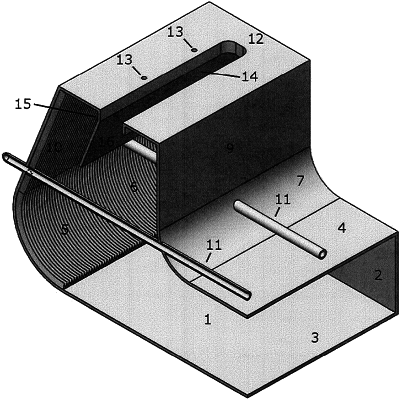| CPC F23D 14/125 (2013.01) [F23D 14/22 (2013.01); F23D 14/32 (2013.01); F23D 14/48 (2013.01); F23D 14/66 (2013.01); F23D 14/78 (2013.01); F23N 1/025 (2013.01); F23D 2214/00 (2013.01); F23N 2225/16 (2020.01)] | 7 Claims |

|
1. A substantially metallic burner configured to operate at a service temperature of not less than about 1200° C. for a cracking furnace operating with walls at temperatures from 700° C. to 1350° C., the burner comprising:
a substantially metallic flow passage comprising a downstream outlet and at least one upstream inlet for at least a gaseous oxidant, the flow passage comprising a wall having an internal surface and an external surface, the external surface facing the cracking furnace;
at least one baffle directing the flow of the oxidant or the oxidant and fuel against the internal surface of the wall;
one or more arrays of heat convective surfaces that are ribs that define at least one continuous series of parallel channels at least on the internal surface of the portions of the burner exposed to the cracking furnace, wherein the channels have a height to width ratio from 0.1 to 2; and
a metallic fuel line that terminates proximate the external front surface for said flow passage from 25 to 75% of the height of the front of the flow passage, wherein said flow passage has a thickness from 4 to 25 mm, wherein:
said substantially metallic flow passage comprises a lower metal flow section comprising an open back end, closed lower side walls and a closed bottom wall, a top wall which does not extend the full length of the lower side walls to define an open upward facing vent in the upper front end of the flow passage, and a lower metal front wall continuous with the bottom wall;
said substantially metallic flow passage comprises an upper metal flow section comprising a chamber defined by an upper front wall connected to the lower front wall of the lower metal flow section upper side walls, a back wall, an open top, and an open bottom which co-operates with the open upward facing vent of the lower metal flow section, wherein said upper front wall and back wall having openings therein at substantially the same height and lateral displacement to provide for one or more fuel supply lines passing from the back to the front of said upper metal flow section, wherein the upper front wall is said wall whose external surface faces the cracking furnace;
the burner comprises either:
a) one or more metal, or ceramic coated metal, top plates cooperating with the open top of the upper metal flow section, said one or more top plates having a planar surface and having a curved leading edge and one or more circular passageways there through, and a back section having one or more polygon outlets for said one or more gaseous oxidant there through; or
b) a continuation of the upper front wall extending to the back wall of the upper metal flow section, said continuation having a leading edge curved and having one or more circular passageways there through, and a planar back section having one or more polygon outlets for the oxidant there through, said back section being coated with a ceramic; and
the at least one baffle extends forward from the top wall of said lower metal flow section into from 45 to 85% of the open area in the chamber of said upper metal flow section.
|